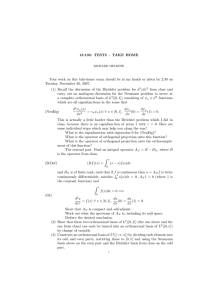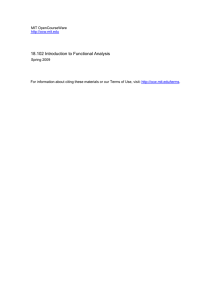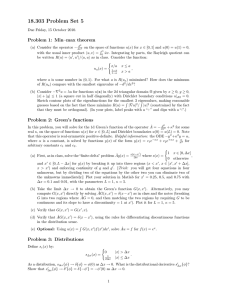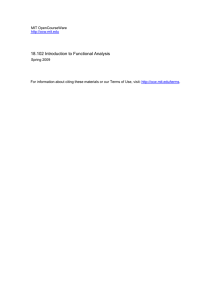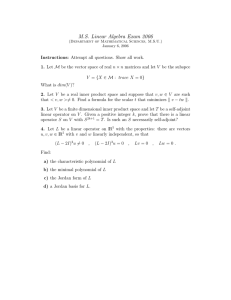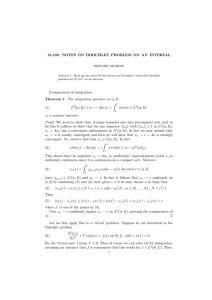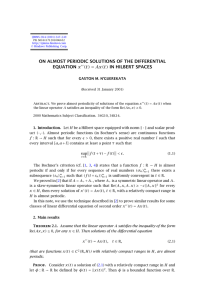18.102 Introduction to Functional Analysis
advertisement
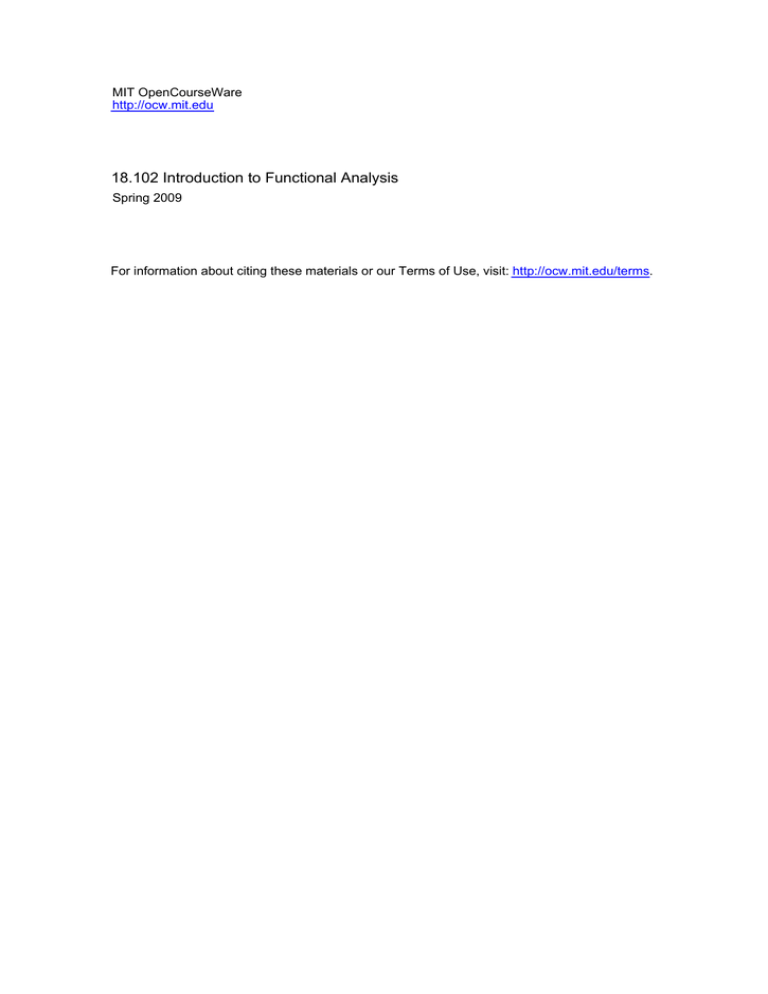
MIT OpenCourseWare
http://ocw.mit.edu
18.102 Introduction to Functional Analysis
Spring 2009
For information about citing these materials or our Terms of Use, visit: http://ocw.mit.edu/terms.
PROBLEM SET 9 FOR 18.102, SPRING 2009
DUE 11AM TUESDAY 28 APR.
RICHARD MELROSE
Corrections to earlier versions
My apologies for all these errors. Here is a list – they are fixed below (I hope).
(1) In P9.2 (2), and elsewhere, C ∞ (S) should be C 0 (S), the space of continuous
functions on the circle – with supremum norm.
(2) In (P9.2.9) it should be u = F v, not u = Sv.
(3) Similarly, before (P9.2.10) it should be u = F v.
(4) Discussion around (P9.2.12) clarified.
(5) Last part of P10.2 clarified.
This week I want you to go through the invertibility theory for the operator
d2
+ V (x))u(x)
dx2
acting on periodic functions. Since we have not developed the theory to handle this
directly we need to approach it through integral operators.
Before beginning, we need to consider periodic functions.
(P9.1)
Qu = (−
1. P9.1: Periodic functions
Let S be the circle of radius 1 in the complex plane, centered at the origin,
S = {z; |z| = 1}.
(1) Show that there is a 1-1 correspondence
(P9.1.1) C 0 (S) = {u : S −→ C, continuous} −→
{u : R −→ C; continuous and satisfying u(x + 2π) = u(x) ∀ x ∈ R}.
(2) Show that there is a 1-1 correspondence
�
(P9.1.2) L2 (0, 2π) ←→ {u ∈ L1loc (R); u�(0,2π) ∈ L2 (0, 2π)
and u(x + 2π) = u(x) ∀ x ∈ R}/NP
where NP is the space of null functions on R satisfying u(x + 2π) = u(x)
for all x ∈ R.
(3) If we denote by L2 (S) the space on the left in (P9.1.2) show that there is a
dense inclusion
(P9.1.3)
C 0 (S) −→ L2 (S).
So, the idea is that we can think of functions on S as 2π-periodic functions on
R.
1
2
RICHARD MELROSE
2. P9.2: Schrödinger’s operator
Since that is what it is, or at least it is an example thereof:
d2 u(x)
+ V (x)u(x) = f (x), x ∈ R,
dx2
(1) First we will consider the special case V = 1. Why not V = 0? – Don’t try
to answer this until the end!
(2) Recall how to solve the differential equation
−
(P9.2.1)
d2 u(x)
+ u(x) = f (x), x ∈ R,
dx2
where f (x) ∈ C 0 (S) is a continuous, 2π-periodic function on the line. Show
that there is a unique 2π-periodic and twice continuously differentiable
function, u, on R satisfying (P9.2.2) and that this solution can be written
in the form
�
(P9.2.3)
u(x) = (Sf )(x) =
A(x, y)f (y)
−
(P9.2.2)
0,2π
0
2
where A(x, y) ∈ C (R ) satisfies A(x + 2π, y + 2π) = A(x, y) for all (x, y) ∈
R.
Extended hint: In case you managed to avoid a course on differential
equations! First try to find a solution, igonoring the periodicity issue. To
do so one can (for example, there are other ways) factorize the differential
operator involved, checking that
d2 u(x)
dv
du
−u
+ u(x) = −(
+ v) if v =
2
dx
dx
dx
since the cross terms cancel. Then recall the idea of integrating factors to
see that
du
dφ
− u = ex , φ = e−x u,
dx
dx
(P9.2.5)
dv
−x dψ
+v =e
, ψ = ex v.
dx
dx
Now, solve the problem by integrating twice from the origin (say) and hence
get a solution to the differential equation (P9.2.2). Write this out explicitly
as a double integral, and then change the order of integration to write the
solution as
�
�
(P9.2.6)
u (x) =
A� (x, y)f (y)dy
−
(P9.2.4)
0,2π
�
where A is continuous on R × [0, 2π]. Compute the difference u� (2π) − u� (0)
�
du�
�
and du
dx (2π) − dx (0) as integrals involving f. Now, add to u as solution
x
−x
to the homogeneous equation, for f = 0, namely c1 e + c2 e , so that the
du
new solution to (P9.2.2) satisfies u(2π) = u(0) and du
dx (2π) = dx (0). Now,
check that u is given by an integral of the form (P9.2.3) with A as stated.
(3) Check, either directly or indirectly, that A(y, x) = A(x, y) and that A is
real.
(4) Conclude that the operator S extends by continuity to a bounded operator
on L2 (S).
PROBLEMS 9
3
(5) Check, probably indirectly rather than directly, that
S(eikx ) = (k 2 + 1)−1 eikx , k ∈ Z.
(P9.2.7)
(6) Conclude, either from the previous result or otherwise that S is a compact
self-adjoint operator on L2 (S).
(7) Show that if g ∈ C 0 (S)) then Sg is twice continuously differentiable. Hint:
Proceed directly by differentiating the integral.
(8) From (P9.2.7) conclude that S = F 2 where F is also a compact self-adjoint
1
operator on L2 (S) with eigenvalues (k 2 + 1)− 2 .
(9) Show that F : L2 (S) −→ C 0 (S).
(10) Now, going back to the real equation (P9.2.1), we assume that V is contin­
uous, real-valued and 2π-periodic. Show that if u is a twice-differentiable
2π-periodic function satisfying (P9.2.1) for a given f ∈ C 0 (S) then
(P9.2.8)
u + S((V − 1)u) = Sf and hence u = −F 2 ((V − 1)u) + F 2 f
and hence conclude that
(P9.2.9)
u = F v where v ∈ L2 (S) satisfies v + (F (V − 1)F )v = F f
where V − 1 is the operator defined by multiplication by V − 1.
(11) Show the converse, that if v ∈ L2 (S) satisfies
v + (F (V − 1)F )v = F f, f ∈ C 0 (S)
(P9.2.10)
then u = F v is 2π-periodic and twice-differentiable on R and satisfies
(P9.2.1).
(12) Apply the Spectral theorem to F (V − 1)F (including why it applies) and
show that there is a sequence λj in R \ {0} with |λj | → 0 such that for all
λ ∈ C \ {0}, the equation
λv + (F (V − 1)F )v = g, g ∈ L2 (S)
(P9.2.11)
has a unique solution for every g ∈ L2 (S) if and only if λ =
� λj for any j.
(13) Show that for the λj the solutions of
λj v + (F (V − 1)F )v = 0, v ∈ L2 (S),
(P9.2.12)
are all continuous 2π-periodic functions on R.
(14) Show that the corresponding functions u = F v where v satisfies (P9.2.12)
are all twice continuously differentiable, 2π-periodic functions on R satis­
fying
d2 u
+ (1 − sj + sj V (x))u(x) = 0, sj = 1/λj .
dx2
(15) Conversely, show that if u is a twice continuously differentiable, 2π-periodic
function satisfying
(P9.2.13)
−
d2 u
+ (1 − s + sV (x))u(x) = 0, s ∈ C,
dx2
and u is not identically 0 then s = sj for some j.
(16) Finally, conclude that Fredholm’s alternative holds for the equation (P9.2.1)
(P9.2.14)
−
Theorem 1. For a given real-valued, continuous 2π-periodic function V
on R, either (P9.2.1) has a unique twice continuously differentiable, 2π­
periodic, solution for each f which is continuous and 2π-periodic or else
4
RICHARD MELROSE
there exists a finite, but positive, dimensional space of twice continuously
differentiable 2π-periodic solutions to the homogeneous equation
d2 w(x)
+ V (x)w(x) = 0, x ∈ R,
dx2
�
and (P9.2.1) has a solution if and only if (0,2π) f w = 0 for every 2π­
periodic solution, w, to (P9.2.15).
(P9.2.15)
−
3. Not to be handed in, just for the enthusiastic
Check that we really can understand all the 2π periodic eigenfunctions of the
Schrödinger operator using the discussion above. First of all, there was nothing
sacred about the addition of 1 to −d2 /dx2 , we could add any positive number
and get a similar result – the problem with 0 is that the constants satisfy the
homogeneous equation d2 u/dx2 = 0. What we have shown is that the operator
d2 u
u+Vu
dx2
applied to twice continuously differentiable functions has at least a left inverse
unless there is a non-trivial solution of
d2 u
(P9.2.2)
− 2 u + V u = 0.
dx
Namely, the left inverse is R = F (Id +F (V −1)F )−1 F. This is a compact self-adjoint
operator. Show – and there is still a bit of work to do – that (twice continuously
differentiable) eigenfunctions of Q, meaning solutions of Qu = τ u are precisely the
non-trivial solutions of Ru = τ −1 u.
What to do in case (P9.2.2) does have a non-trivial solution? Show that the
space of these is finite dimensional and conclude that essentially the same result
holds by working on the orthocomplement in L2 (S).
(P9.2.1)
u �−→ Qu = −
Department of Mathematics, Massachusetts Institute of Technology
